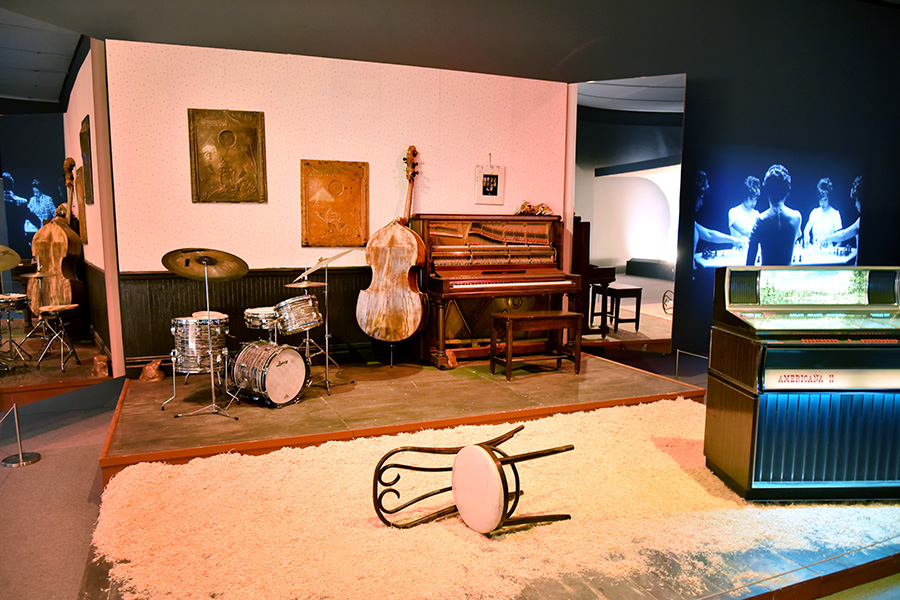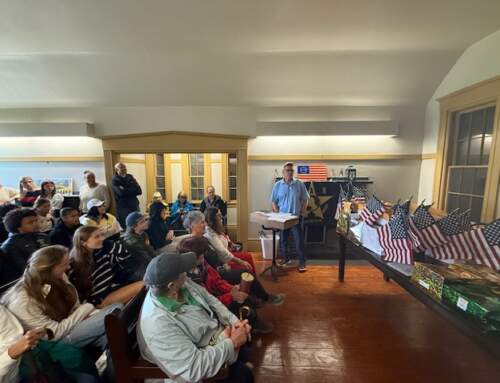By Richard Campbell
It is not often that the visual arts attempt to engage the audience into playing on a jungle gym, but William Forsythe’s “Choreographic Objects” currently installed at the ICA in the Seaport gives the viewer room to romp. The choreographer’s experience-based works coincide with his residency at the Boston Ballet, and would be considered a collaborative effort, bridging the visual arts, writing, and choreography. Where many conceptual artists come to this kind of work without in-depth experience in dance, William Forsythe is coming from a life-long career in classical ballet. After having worked for the Stuttgart Ballet, he was director of Ballet Frankfurt for twenty years, and formed his own Forsythe Company between 2005 and 2015. All that experience adds a power and cohesiveness to these works that bring the conceptual ideas to real experience.
When the peddle hits the meddle the main feature of this work depends upon the viewer’s ability to participate in a kind of rigorous manner that most people don’t expect in an art gallery. There is just enough to view here to arrive at a definition of the artist’s term: “choreographed objects” which in his own words are “hybrids that occupy a single space between art, architecture, and performance, bringing a unique set of experiences to the museum context.” The main gallery which presents the viewer with a maze of athletic exercise rings hanging from a giant steel structure, presents the opportunity for the viewer to create their own choreography by interacting with the installation. You can take the kids to the art museum to let off steam! For many viewers this is a spectator sport, as interacting on this grand torture device in a choreographic manner requires some agility.
This viewer was lucky to have witnessed a dancer in the hall who tested with rigor the various ways to interact with the installation. For a group of gymnasts or dancers this would be a dream come true, and almost as soon as my subject began his interactions- with pretty incredible agility- it became clear that part of the learning curve was in the difficulty of engaging with the maze in a meaningful way. For while it may seem that traversing from one end of the maze to another was sufficient to find purpose, the quest seemed, even in a skilled dancer’s body, more akin to aerobics than choreography. I was reminded more of the swings on Lawn D than I was of art. The sound of the rings clacking together, and the visual confusion caused by them swinging had a certain abstract art feeling.

Surrounding the jungle gym piece were a series of video galleries which drew out the idea of choreography a little more fully. In one large interactive gallery you get to turn yourself (and others do as well) into a pretzel person on a giant set of screens merely by walking through the space. This is a space that would yield most interesting choreography itself if it were tested by experienced dancers- but offers a fun house of games distorting lens that gives new meaning to the term “out of body” experience. Once again, bring the kids! A more focused conceptual piece called “Antipodes” is described as conceived based upon “the artist’s misconception of gravity as a child.” Encompassing the traditional meaning of the term, Antipodes are any two points on the surface of the earth that are directly opposite of each other, the exhibit describes its video as creating “perilous suspension” of the person above the earth. It looks a lot like the videos you see of astronauts in gravity-less environments. The satisfying aspect of this performance is that you get to see the incredible skill of Forsythe himself performing seemingly impossible balletic moves. The accompanying text for this exhibit is one that will become a classic on the shelves of performing arts libraries around the world.
In contrast to Forsythe’s very conceptual work, jazz pianist/visual artist Jason Moran’s works are pretty down to earth re-creations of a time period in jazz history, concretely showing iconic jazz instruments, videos, and installations that depict what is elemental about jazz musicians and their environments. The program notes claim is: “he grounds his practice in musical composition and bridges the visual and performing arts through stagecraft.” Looking a lot like something you might see in the Smithsonian his “sets” create an environment that recalls well known jazz venues (Slugs Saloon) and artists from the past. His staged work has its own life that is at once irresistible in a way that standard museum pieces don’t quite fulfill. He bases the structure of much of the works on his deep performance knowledge of playing “sets” a term that truly describes the culture of jazz rehearsal and performance.
There have been short staged performances of jazz musicians throughout the exhibition with artists who have collaborated with Moran to bring the sets to life. This show, coming from the Walker Art Center in Minneapolis, has accompanying video that is entertaining and light, like the quizzical video “Chess” by Lorna Simpson in which she and jazz musicians play chess and piano in 3 channeled black and white video montages. Other video works like Kara Walker’s video, in collaboration with Alicia Hall and Jason Moran entitled “Six Miles from Springfield on the Franklin Road, 2009” are more disturbing and depict racially motivated violence of slavery channeled through her research on the Freedman’s Bureau Report which was created by Congress during Lincoln’s administration. Certain installations by Moran are there for the viewer just to imagine staged settings by themselves, like the Savoy Ballroom piece. We can only hope that jazz will find a revival someday, as it seems ever more, (despite being the original American musical form), to be almost entirely overlooked by contemporary Americans.
These shows and more make the holiday season at the ICA a glimpse at contemporary art that is thought provoking and mildly amusing, without being too over the top conceptually to make them more digestible for the museum visitor new to this kind of art. Remember that the ICA is FREE on Thursday nights, 5PM to 9PM, but the museum accepts donations for those who can afford to make them. For more details on admission prices go to: https://www.icaboston.org/visit. The ICA is located at 25 Harbor Shore Drive in the South Boston Seaport, accessible by the MBTA via the Red Line and the Silver Line. The museum is a short walk from the Courthouse Station, and there is parking available. Bring the Kids!






